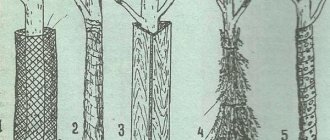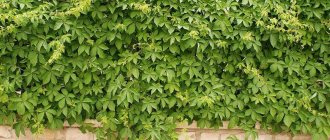Covering material for roses. Installing arcs
Let us choose, as an example, the simplest rectangular one- or two-row rose garden to cover. The most common is the tunnel method using arcs. These can be metal or greenhouse arcs in a green plastic braid.
Rigidity is important: in winter they should not be pressed under the weight of snow. Depending on the size and age of the bushes, as well as the degree of bending of the roses to the ground, the length of the arc can vary from 1 to 2 m. Also, the arcs should not be too long (preferably no more than 2.5 m). Taking into account the entry of the arc into the ground at both ends, the height of the shelter itself should ideally not be higher than 1 m. As we have already said, the shelter should end up completely under the snow.
Next, above the bent and fixed rose bushes, you need to install arcs every 40 - 50 cm, pressing them into the ground. There should be an air gap of 5-10 cm above the bushes. A very stable and strong structure will be obtained if you install arcs crosswise over each bush. And if the distance between the bushes is more than 1 - 1.5 m, place arches between them so that the shelter does not sag under the weight of the snow. When the arches are installed over the entire rose garden, cover them with two layers of thick covering material. It’s easier to do this together.
Among the whole variety of covering nonwoven materials, the best results are obtained by agrospan, agrotex, spunbond or their analogues with a thickness of at least 60 microns. As a rule, the material is sold already folded in two layers; as a result, the total thickness of the web should be at least 120 microns.
To cover roses, you can only use white covering material - the sun's rays should be reflected and not absorbed by it. Under the black material, the air temperature and humidity will be too high. Roses in such conditions most often wither away.
After the tunnels are covered with two layers of canvas, press the excess material on the sides and ends to the ground using available means - bricks, boards, stones, tiles. I’ll also tell you about one trick: when calculating the size of the covering fabric, add about 60 cm of material from the ends. After you throw it over the frame of arcs, pull it tightly from the ends, and secure the remaining tails to the ground with two arcs or pins like candy . It is very comfortable!
The design of frames using arcs is universal; with their help, you can reproduce the outlines of any rose garden - wide, round, trapezoidal, irregular or semicircular. It is also convenient to cover single-growing bushes with the help of arcs: you just need to place two or three arcs crosswise over the rose - and the frame is ready.
Agrofibre
Covering grapes for the winter is possible with spunbond or agrofibre - a special covering material of artificial origin, characterized by environmental friendliness. Popular brands are Agrospan, Lutrasil, AgroSUF, Spunbel. The main characteristics of the covering material are as follows:
- The fabric does not allow moisture to pass through and protects well from the sun.
- The material “breathes” and condensation does not accumulate inside the structure.
- Agrofibre can be used several times.
- The use of spunbond is relevant for both southern and northern regions: it protects against heat and frost.
Covering grapes with agrofibre
This covering material is available in different thicknesses. It is advisable that the grapes be covered for the winter with spunbond with a density of 40 g/m2. The fabric is applied as follows:
- The grapes are tied, wrapped in covering material, laid on boards; if necessary, the edges of the argyle fiber should be pressed with stones or other press.
- The grapes are removed with support, then they need to be bent to the ground and wrapped in spunbond.
- Wire arcs are installed above the bushes (stuck into the soil), an argyle fiber is covered on top, the edges of which are sprinkled with earth. Before cold weather, you can leave a small gap for better air passage; with the onset of frost, it must be securely closed.
Keep in mind that dense spunbond does not protect against extremely low temperatures, so additionally lay a thermal insulation layer. In addition, be aware that arg fiber allows moisture to pass through: drops of water freeze to the grapes, which is unfavorable for the plant. To avoid the accumulation of liquid inside the structure, organize appropriate additional protection for the winter: use film, polyethylene.
Covering grapes with film for the winter
Is it possible to cover roses with black spunbond? Choosing a covering material
One of the common mistakes made by most inexperienced gardeners is wrapping the stems too tightly with covering material. Also, very often the gardener does not think about the fact that it is necessary to choose the most suitable material for covering roses; instead, the plants are covered or sprinkled with any of the first raw materials that come to hand.
You can cover roses for the winter using material purchased in a store or by constructing such protection yourself.
Purchased
The most popular and affordable insulation on the market is polyethylene film. This material is recommended by experts for the most susceptible varieties, due to its ability to retain a layer of air from the inside and not interfere with oxygen exchange processes when wrapped loosely.
In addition, stores offer several types of spunbond, which can be purchased in rolls or in packages of ten linear meters. These include:
- agil;
- agrospan;
- agroSUF;
- lutrasil;
- agrotex.
Their advantages are as follows:
- unobstructed air passage;
- ensuring aeration;
- wind protection;
- increasing the temperature inside the shelter by several degrees.
These materials are also durable and have a long service life.
Available means
Some gardeners, saving money, use improvised covering material so that the roses can overwinter freely. In this case, old burlap, spruce branches, rags, fallen leaves, sand, sawdust or peat are used.
These products cannot be called ideal, since they are suitable for service for no more than one winter and are inconvenient for transportation.
Purchased
Industrially produced covering materials for roses for the winter have different composition, price, and quality. Agrotextiles are sold in rolls or pieces of a certain format. Covering properties are determined by density; it is measured in g/m². The higher the value, the more reliable the protection.
Lutrasil
Lightweight durable material for long lasting use. Can be used for several seasons. Advantages of lutrasil:
- allows air to pass through;
- there is no greenhouse effect underneath;
- the canvas does not get wet.
To protect the flower garden from frost, white lutrasil with a density of 60 g/m² is best suited. Roses are covered with material folded in 2 layers.
To cover the bushes, you can use less dense material (30-50 g/m²). It is rolled into 3-4 layers. A linear meter of lutrasil costs from 25 to 50 rubles. For erect, thick shoots, they sew covers with their own hands from covering material. Flexible varieties of roses are bent to the ground, leaving a gap to the ground (10-20 cm), arches are placed, and a non-woven fabric is thrown over it. It is fixed on the sides with studs, bricks, and boards.
Geotextiles
Geotextiles have long been used in industrial rose gardens in the Moscow region. The fabric is sewn together from 3 layers, covering large areas. All varieties of roses winter well under it without hilling. Group plantings are covered in one piece. Covers are sewn for standard and climbing types of roses.
The canvas is laid on arches or supports, this allows you to distribute the snow load. Leaves are removed from the bushes and bent down. The soil is covered with mulch from a mixture of dry sawdust and horse manure.
Geotextiles are used in construction and landscape design. It consists of polymer fibers. They sell it in rolls of different widths. You can purchase ready-made geotextile covers in gardening stores. Advantages of the material:
- strength;
- durability;
- frost resistance;
- environmental friendliness;
- air and water permeability;
- no condensation.
Polyethylene film
The attitude towards film as a means of protection against frost among flower growers is not clear. There are negative reviews, but many people use it successfully. In regions with harsh winters and thick snow cover, roses winter well under the cover of plastic film. The air cushion underneath protects the roots and shoots of roses from freezing.
Spunbond
This material can be used for several seasons.
It allows water and air to pass through. The cost of spunbond is not high, which makes it affordable. It is used for wrapping single standard-type bushes, stretched onto frames made of plastic (metal) arcs, bars, and willow rods. Spunbond is used in 2-3 layers, only white in density:
Sackcloth
Jute or polypropylene sugar bags are a budget option for covering roses for the winter. They are placed on separately growing bushes. Dry leaves are poured inside, the bottom is secured with twine and covered with earth. Vegetable nets are filled with dry fallen leaves and used as insulation.
Construction Materials
Materials left over after the construction of dachas and country houses can be useful. Boards and bars are used for the construction of shields and houses. Ruberoid is laid on the ground before the shoots are placed on it. Huts for roses are built from sheets of slate. The tree trunk circles are mulched with expanded clay.
Available means
To fix the covering material, various available materials are used:
- ropes;
- leg-split;
- pegs made of wood or reinforcement;
- welding electrodes instead of staples;
- pieces of wire;
- boards;
- bricks.
Spruce spruce branches
Lapnik is not available to everyone. It is used by those who live near coniferous forests. It is not suitable for covering large rose gardens; you need a lot of it. To protect low-growing rose bushes from frost, you need to create a layer of branches at least 30 cm thick.
A shelter made of spruce branches must be covered with snow, and covering material must be pulled over it if there is no snow. You can cover roses with spruce branches when the daytime temperature drops to -6 °C.
Leaves
In autumn there are plenty of leaves in any garden. They can be used for frost protection if the trees are healthy. You can only fill rose bushes with dry material. Wet leaves provoke the development of fungal diseases in roses.
Leaves without additional shelter will fly away. To secure them around the bush, cardboard boxes, nets, fine-mesh plastic mesh, wooden boards, and other available materials are used.
Sawdust
It is better to use sawdust in combination with other types of shelters (shields, covering material). They are more suitable for regions with harsh winters, where thaws are very rare. Not all sawdust is suitable for covering a flower bed. Can not use:
- fine fraction;
- furniture production waste containing chemicals.
It is better to use softwood sawdust with a size of 10 mm or more as a covering material. They caking less, are hygroscopic, and have antiseptic properties. They insulate with sawdust in different ways:
- they fill up the tree trunk circle, put shields over the bushes, and cover them with film;
- The nets are not tightly filled with sawdust, they are placed under the lashes, arches are placed on top, and covering material is thrown on;
- in the northern regions, shields are placed like a house over low bushes, and they are covered with a thick layer of sawdust.
Humus
This organic material will not protect the above-ground part of the flower from frost. It is used to mulch the soil, it protects it from freezing and increases fertility. Humus is mixed with dry sawdust to make it looser.
Geotextile covering material for roses. Geotextiles for covering roses
Autumn has come, the cold is getting closer and closer. For gardeners, the question arises of protecting their favorite plants from frost. Rose and strawberry bushes, just like people, need to dress in warm “fur coats”. What or with what to cover perennial plants before the onset of cold weather? What covering material should gardeners use? We suggest using environmentally friendly geomaterials based on polymer threads. This is exactly the kind of material that is easy to use and, importantly, not expensive. Covering material made of geotextile or will be durable and highly resistant to aggressive environmental influences. It will not only help protect your perennial plants from the cold, but will also preserve the unique landscape design of your site.
The European Road Technologies company offers rolls of geomaterial up to 6 meters, which can cover not only flowers and shrubs, but also fairly tall trees.
Protecting flowers in winter
Beautiful rose bushes and various exotic plants are real decorations for your garden. In order to preserve this splendor in the Russian winter, we need to take care of their protection. There are plants that require mandatory protection.
- These are, of course, roses, but apart from park roses;
- Southern plants such as grapes and lavender;
- Evergreens, cypress, juniper, etc.;
- Flowering shrubs and perennial flowers;
- Various seedlings in pots and seedlings of winter-hardy plants, cedar, spruce and pine.
Such plants left without protection can, at best, lose their crown, and at worst, freeze completely.
The most popular design used to protect plants is a rigid frame made of metal, plastic or wooden rods. Such a frame is usually made in the form of a pyramid or hemisphere, which is then covered with various protective materials, in our case geotextiles.
We protect plants with geotextiles
As already mentioned, this is a material supplied in rolls and made from polymer fibers. Geotextile has found wide application in road construction, civil engineering, drainage systems and, of course, landscape design.
The most important advantage of geotextiles for protecting your roses is the ability to allow air to pass through, which creates a favorable microclimate inside the protective space in the form of a cap or sphere. The leaves and petals under such a “breathable” protective material are in an air environment that contains the ideal moisture content and, as a result, the plants do not rot or rot. Plants protected by geotextiles can be covered with snow, which will serve as additional natural insulation.
Geotextiles have a lot of useful properties, but for us its most important property is frost resistance. Unlike other covering materials (mats, newspapers, reed mats, etc.), geotextiles can be used repeatedly and are environmentally friendly, which means they will not pollute your suburban area and will not emit substances that can have a negative impact on your plants or onto the soil. Given its strength, geotextiles can be easily cut with any knife or scissors, are highly resistant to chemicals and are resistant to fungus.
The process of warming plants should begin in October, with the onset of the first frosts. It is necessary to remove protection from bushes in the spring, but you should not rush, because... The first warm rays of the sun can damage the tender new leaves and affect their further growth.
Which geotextile to choose for plant protection
The company European Road Technologies for plant protection offers an optimal density of 100 g/m2. An ideal white canvas, the white color indicates the high quality of the material. Garden geotextiles are supplied in rolls 1.5 meters wide, which will be ideal and cost-effective for small areas. For larger scales there are rolls up to 6 meters.
Protecting plants from the cold with geotextiles is currently the most progressive method. Durable, environmentally friendly and breathable material that contains all the advantages of modern synthetic materials.
Our choice is GEOTEXTILE!
Preparing roses for winter: features
The process of preparing any plant for winter, including roses, is not as simple as it seems at first glance. First, you need to carry out sanitary and preparatory measures, and only at the final stage is covering material for roses required. How to cover roses for the winter correctly? The question is relevant both for a novice gardener and for a more experienced one.
First, you need to determine whether the plant is ready for winter. If a rose bush has shoots colored red in September, this is a sign of active growth. The plant is not ready for winter, has not accumulated the required amount of carbohydrates, and the shoots have not yet become woody. Rose needs help. To do this, the bushes are fed with phosphorus fertilizers, the growing point is pinched and faded buds are removed.
Secondly, from the beginning of September, you should stop loosening the soil around the roses and the process of plant formation. This is required to prevent stimulation of the growth of shoots from dormant buds. At the end of October - beginning of November, all leaves are removed from the plant. This is done in order to prevent them from rotting under cover in winter.
Thus, before covering roses for the winter with a covering material, the features of the latter should be carefully studied. And weigh all the positive and negative aspects.
The birthplace of roses is Italy. There in winter the temperature does not drop below +3 °C. Russian flower growers have to prepare flowers for wintering and protect them from frost. On sale are ready-made shelters in the form of winter houses for roses, removable covers, stakes for shelters, and industrial covering materials. To preserve flower collections, industrial products and scrap materials are used.
Covering material: fur coat for roses and grapes. How to cover a vineyard? Gardener's experience (part 2)
For several years now, our shelter has included three elements.
Welded mesh 1–1.5 m wide (depending on the depth of the trench). We cut the mesh into easy-to-use one and a half meter fragments and bend it into the letter “P” with a crossbar along the width of the trench and “legs” of 30–40 cm each, so that the “letter” almost does not rise above the trench and the snow does not fall off it in winter.
Dense (60 g/m2) non-woven covering material, which in areas with severe frosts can be folded in half. The inside of such a shelter is usually drier and warmer than the outside. In frosty weather this difference is especially great.
Thick durable polyethylene film. It is convenient to purchase all these materials in rolls for many years of use. Tunnel shelters made from these three components can be assembled by two people quickly and without fuss - my husband and I spend no more than 2.5 hours on our 130 bushes.
Instead of non-woven covering material, you can use straw or reed mats, instead of film - slate, cuttings of roofing felt or roofing felt. Leave the ends open until constant negative temperatures are established. When constant frost sets in, we close them - not tightly and with the covering material folded inward. In each trench we first place 3-4 rags soaked in used machine oil, or pieces of burnt felt - to repel mice and others like them.
Some winter-hardy grape varieties require almost no shelter in non-extreme winters - just place the cut vine on boards or spruce branches and cover the top with a piece of roofing felt or roofing felt to avoid getting wet. In areas where there is a lot of snow, for some varieties you can also use only a light cover, the rest will be successfully completed by snow. If you do not live near a vineyard in winter and cannot control the situation, it is useful to place a snow retention shield nearby.
But if the winter has little snow, the grapes may still freeze. And therefore, in our risky gardening zone, I prefer to provide all varieties of grapes, even the most frost-resistant, with standard air-dry shelter. And they are even more valuable: without shelter they could withstand no more than -25–28 degrees, while in our area -40 is not uncommon. Well, young plants up to 2–3 years of age, regardless of the declared frost resistance of the variety, must be covered.
How to cover roses if there is no spruce branches. Covering with spruce branches without using supports
For this type of protection you will need spruce or pine branches. Branches can be used fresh or last year, cut from the tree or found broken. If it is not possible to find spruce branches, then you can simply collect branches from available trees or shrubs: birch, elderberry, currant after pruning for the winter, and so on.
- Place the selected branches on the side where you will bend the stems. It is better to work with branches of coniferous trees with gloves so as not to prick your hands;
- Bend the twisted lashes of the rose and cover the top with spruce branches again. If the stems do not bend, then you can tie the spruce branches on one side and cover the bush with them from above, like a pyramid;
- over this structure you need to stretch a covering material: spunbond, lutrasil or geotextile (1-2 layers, depending on its density);
- secure the material by pressing it down on all sides with bricks or boards.
Frame-based shelter
The role of the box can be played by plastic or metal arches, a wooden box with sparsely nailed planks.
- install a frame over the bush so that there is free space between the stems and the inner surface of the shelter;
- Cover the resulting structure with any non-woven material, cardboard or polypropylene bags. Cardboard retains heat well and is a breathable material, but it gets wet, so it will have to be covered with film on top;
- press the covering material along the edges with something heavy.
Shield shelter
The design resembles a hut in appearance and consists of two shields, knocked down at an angle. This structure is placed above bushes or rose vines, and covered with film or non-woven material on top to provide warmth and air.
With air-dry methods (with or without a box, shields), you need to periodically, especially during thaws, lift the edge of the covering material for ventilation.
Shelter technology
The technology is simple. Pre-prepared rose bushes are twisted and tied in the form of arches (not too high) to arches pre-installed in the garden bed. Then roofing felt is laid, and polyethylene is placed on top. It is important to press the edges of the material to limit the entry of moisture. The main purpose of any shelter is to create an air cushion inside where warm air will circulate. In the spring, the cover is removed gradually: first, the end sides are opened so that the roses are not blocked, and when the weather warms up, the bushes are completely freed.











